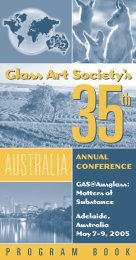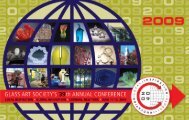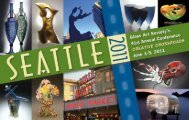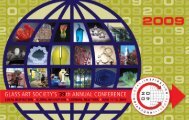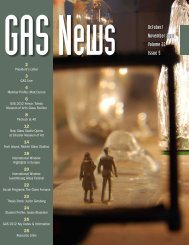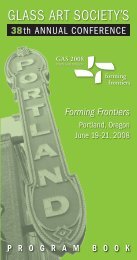letter from the GAs President new Membership ... - Glass Art Society
letter from the GAs President new Membership ... - Glass Art Society
letter from the GAs President new Membership ... - Glass Art Society
Create successful ePaper yourself
Turn your PDF publications into a flip-book with our unique Google optimized e-Paper software.
<strong>Glass</strong> Life After Katrina: Surviving, Recovering, Moving On<br />
By Laurel Porcari<br />
The story is all too familiar: on August 29 2005<br />
Hurricane Katrina struck <strong>the</strong> gulf coast causing extreme<br />
damage. New Orleans was brought to <strong>the</strong> brink of extinction<br />
when <strong>the</strong> flood walls broke and water covered<br />
portions of <strong>the</strong> city that are below sea level. In one day<br />
<strong>the</strong> lights went out – everywhere and for everyone.<br />
This is not an update on <strong>the</strong> city’s recovery, nor is it<br />
an exposé on aid, fatigue, or any o<strong>the</strong>r political issue that<br />
might be associated with <strong>the</strong> storm. This is an update on<br />
people that make glass and how <strong>the</strong> storm has changed<br />
things in <strong>the</strong>ir world.<br />
It’s hard to explain <strong>the</strong> magnitude of what happened<br />
here. People who did <strong>the</strong> right things – worked<br />
hard, opened businesses, developed <strong>the</strong>ir talents, had<br />
national and international reputations – were effected<br />
so badly that for a year or more, a mere fraction of <strong>the</strong><br />
studios that were open before <strong>the</strong> storm were operating.<br />
Imagine that, if you can. In one day <strong>the</strong> lights went out<br />
and every studio was made inoperable.<br />
It was not until January of 2006 that <strong>the</strong> actual<br />
meaning of what happened became clear to us, <strong>the</strong><br />
glass community as a whole. Until that time, we were<br />
all wrangling with stabilizing our personal situations.<br />
Then, in January, <strong>the</strong> Craft Emergency Relief Fund<br />
held an emergency meeting at <strong>the</strong> Ogden Museum of<br />
Sou<strong>the</strong>rn <strong>Art</strong>. Present at <strong>the</strong> meeting were all <strong>the</strong> key<br />
representatives of <strong>the</strong> arts in Louisiana: <strong>the</strong> Louisiana<br />
Division of <strong>the</strong> <strong>Art</strong>s, New Orleans <strong>Art</strong>s Council, Cultural<br />
Economy Foundation, Jazz and Heritage Foundation,<br />
etc. As well, <strong>the</strong>re were key artists present. The greatest<br />
presence was <strong>the</strong> coalesced glass community: Eddie and<br />
Angela Bernard of Wet Dog and Conti <strong>Glass</strong>, Gene Koss<br />
of Tulane University, Mitchell Gaudet of Inferno, Mark<br />
Rosenbaum of Rosetree, Jimmy Vela, Carlos Zervigon,<br />
Andy Brott, Claire Kelly and Anthony Schafermeyer,<br />
myself, and more. What became apparent to <strong>the</strong> glass<br />
community was that it was on its knees. Each of <strong>the</strong><br />
bigger studios had employed o<strong>the</strong>r glass artists and<br />
<strong>the</strong>y had to let <strong>the</strong>m go. Conti had flooded and was no<br />
longer in operation, leaving not only <strong>the</strong>ir employees<br />
but <strong>the</strong> nearly fifty glass artists that relied on that facility<br />
with no means to produce work. Inferno’s facility was<br />
badly damaged, as was its major tenant, Vella Vetry. Even<br />
Tulane, a major University, was closed, so <strong>the</strong>re were no<br />
teachers or students.<br />
The result of that meeting, aside <strong>from</strong> <strong>the</strong><br />
depressing reality hitting home, was that we had to<br />
work toge<strong>the</strong>r. We needed help <strong>from</strong> whatever agencies<br />
were ready to deliver aid and that only by acting<br />
toge<strong>the</strong>r would we be heard. And, lets be honest, <strong>the</strong><br />
arts are not a priority at <strong>the</strong> best of times, so we had<br />
some work to do.<br />
Gutted Conti Studio contents<br />
ready to be scooped up,<br />
October 2005<br />
The first collective thought regarding actual<br />
facilities was to somehow push to get Conti <strong>Glass</strong><br />
reopened. The reality was that it was damaged beyond<br />
what <strong>the</strong> Bernards could bear. And this is despite heroic<br />
efforts on <strong>the</strong>ir part. The solution that we all came up<br />
with was to reorganize <strong>the</strong> studio as a non-profit. By<br />
February, <strong>the</strong> non-profit had a name, (New Orleans<br />
Creative <strong>Glass</strong> Institute), a board, donors and a mission:<br />
to inspire creativity, to educate and perpetuate <strong>the</strong><br />
glass community, to invest in art glass industries, and<br />
to promote and nurture <strong>the</strong> culture of New Orleans’<br />
contemporary glass art community.<br />
The next installment in this series will describe<br />
NOCGI as it is today, and introduce you to an individual<br />
artist and <strong>the</strong>ir road to recovery.<br />
Beyond <strong>the</strong> Bake Sale: Fundraising for College <strong>Glass</strong> Programs<br />
By Robin Cass<br />
Many college glass programs face funding<br />
of procuring enough work to auction, it can be difficult<br />
is to have students agree on a few particular designs at<br />
challenges for basic supplies, facilities upgrades, or<br />
to find an appropriate space and figure out staffing<br />
a range of price points. At <strong>the</strong> actual sale, <strong>the</strong> resulting<br />
“extras” such as visiting artists and student participation<br />
requirements during <strong>the</strong> event itself. It’s possible to run<br />
work looks far more professional and appealing than<br />
in GAS conferences. Grants <strong>from</strong> organizations or<br />
up considerable shipping expenses too if requesting<br />
<strong>the</strong> usual flea market assortment.<br />
generous individuals are welcome influxes for special<br />
work <strong>from</strong> distant artists.<br />
One version of <strong>the</strong> usual craft sale is a <strong>the</strong>med sale<br />
projects, but do not address recurring shortfalls. The<br />
need is common; often glass programs have few full-<br />
The “Make-your-own ______” Workshop:<br />
like <strong>the</strong> ubiquitous “<strong>Glass</strong> Pumpkin Patch”. Every o<strong>the</strong>r<br />
glass organization in <strong>the</strong> country has jumped on this<br />
time students but substantial operating expenses.<br />
This imbalance leads to constant searching for <strong>new</strong><br />
ways to raise money. A few fortunate departments<br />
benefit <strong>from</strong> associated groups of supporters and<br />
o<strong>the</strong>rs have established annual events, but most are<br />
left to <strong>the</strong>ir own devices.<br />
The general challenges are familiar; upper<br />
administrators who cannot or will not offer financial<br />
support, no extra staff for development efforts, and<br />
limited resources to dedicate towards fundraising<br />
projects. There is also a need to involve students of<br />
all skill levels in fundraising efforts in ways that don’t<br />
interfere too much with <strong>the</strong>ir educational experience,<br />
and perhaps even enrich it. Here is a summary of some<br />
lessons we’ve learned <strong>from</strong> our many fundraising<br />
attempts here in <strong>the</strong> Rochester Institute of Technology<br />
<strong>Glass</strong> Program.<br />
The Auction:<br />
This approach can work well if you are based<br />
in an area with a art-savvy community that is home<br />
to plenty of potential glass collectors. Auctions of<br />
instructor, alumni, and student work can help establish<br />
and maintain relationships with local supporters,<br />
but this type of event does require a huge upfront<br />
investment of resources. In addition to <strong>the</strong> challenge<br />
These student-lead experiences can involve all<br />
kinds of glass-forming processes, and take advantage<br />
of people’s curiosity about <strong>the</strong> process of working with<br />
glass. They give students valuable teaching experience<br />
as well as <strong>the</strong> chance to develop interpersonal skills.<br />
Workshops can be conducted over a long period of<br />
time so as not to interfere with regular department<br />
activities. On <strong>the</strong> downside, <strong>the</strong>re are safety issues to<br />
be considered when inviting inexperienced people into<br />
a glass studio. Once <strong>the</strong> Risk Management folks are<br />
appeased and all appropriate waivers are drawn<br />
up though, this type of effort can be quite successful.<br />
We’ve also found that our glass program’s reputation<br />
and visibility benefits <strong>from</strong> this kind of interaction with<br />
<strong>the</strong> wider community.<br />
The Sale:<br />
The main challenge with campus “craft sales” is to<br />
maintain some respect for <strong>the</strong> program while making<br />
items that sell. This can be difficult if you live in an area<br />
where people are accustomed to buying Chinese-made<br />
blown glass in huge discount stores. To counter this,<br />
students need to develop salable work that stands<br />
apart <strong>from</strong> such competition, and work hard to educate<br />
possible buyers about <strong>the</strong>ir creative and technical<br />
processes. An approach that seems to be working well<br />
bandwagon. It seems to work out well for all of <strong>the</strong>m<br />
due to an apparently endless market for funky handblown<br />
glass vegetables in most areas. Students at all<br />
skill levels can participate through assisting, grinding,<br />
packing, etc. The impact on o<strong>the</strong>r activities in <strong>the</strong><br />
department can be minimized with careful scheduling<br />
and involvement of outside help. We have had great<br />
success with this type of event and it has become our<br />
sole source of funds for visiting artist workshops.<br />
In conclusion, some significant lessons we’ve<br />
learned <strong>from</strong> our many fundraising efforts:<br />
• Consider partnering with o<strong>the</strong>r organizations or<br />
individuals who can help facilitate advertising and<br />
sales through <strong>the</strong>ir existing networks of potential<br />
supporters.<br />
• Avoid over committing student or instructor time;<br />
fundraising should take a back seat to education.<br />
• Cultivate reciprocal relationships with college<br />
administration and development staff so <strong>the</strong>y are<br />
aware of your long-term goals.<br />
I encourage you to share any advice you can offer as<br />
a result of your own fundraising efforts!<br />
5



